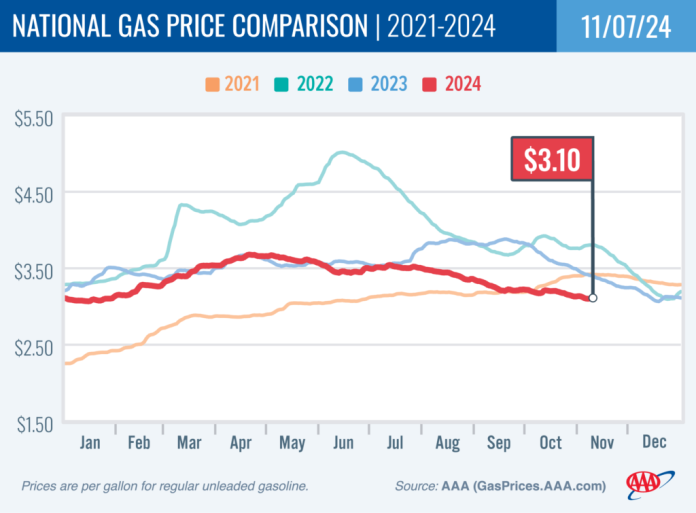The landscape of gas prices is shifting, yet again influenced by external factors such as natural disasters. As Hurricane Rafael churns in the Gulf of Mexico, the national average for gasoline has only dipped slightly to $3.10 a gallon, a decrease of just three cents from last week. This small drop occurs amid a complex backdrop of fluctuating demand, inventory changes, and the realities of a vulnerable oil production chain.
Andrew Gross, spokesperson for AAA, explains the dynamics at play: “Gas prices often freeze as a hurricane enters the gulf and oil production and refining are threatened. But once Hurricane Rafael passes, pump prices should soon regain their downward momentum.” Small business owners who rely on fuel for transportation and operations should prepare for potential price shifts following the storm’s impact on production.
Key Takeaways for Small Businesses
- Current Pricing Trends: As of now, the national average gas price stands at $3.10 per gallon, down seven cents from last month and 30 cents from a year ago. However, the impending impacts of a hurricane could alter these prices again, especially if refining capacity is hindered.
- Electricity Costs: While gas prices are front-page news, public charging at electric vehicle (EV) stations also remains steady at a national average of 34 cents per kilowatt. For businesses considering sustainability measures through EVs, these costs are important for budgeting and planning.
- Demand Fluctuations: The latest data from the Energy Information Administration (EIA) shows a decline in gas demand from 9.15 million barrels per day (b/d) to 8.82 million b/d. Increased gasoline production, averaging 9.7 million barrels daily, and a slight uptick in domestic gasoline stocks from 210.9 million to 211.3 million barrels may stabilize future prices.
Regional Insights
Gasoline prices vary significantly across the United States. Currently, Hawaii tops the list with the highest prices at $4.57 per gallon, while Oklahoma enjoys the lowest at $2.64. Such disparities can heavily influence operational costs for small businesses, particularly those located in high-cost regions. For those in logistics and transportation, keeping an eye on these fluctuations becomes crucial for maintaining profitability.
The Electricity Landscape
For small businesses considering the integration of electric vehicles, understanding the public charging infrastructure is vital. The least expensive states for charging rates include Kansas (21 cents), Missouri (24 cents), and Nebraska (25 cents). In contrast, Hawaii faces charges as high as 56 cents per kilowatt hour, highlighting significant regional disparities that could affect business decisions on fleet management.
Challenges Ahead
While there may be potential for lower gas prices following the hurricane’s departure, small business owners should be wary of volatility. Hurricanes can lead to production delays and supply chain disruptions, which could result in price spikes when the market reacts to recovering demand or supply constraints.
Additionally, businesses that rely heavily on transportation should consider diversifying fuel sources or investing in energy-efficient options to hedge against future price instability. Keeping a close watch on weather forecasts and market reports will be crucial for business planning.
Real-World Implications
For small business owners, the latest gas price metrics and electricity costs serve as a timely reminder of the uncertainty inherent in energy markets. Strategic planning around fuel consumption and budgeting for fluctuating prices can help mitigate negative impacts on cash flow.
As the industry awaits the hurricane’s impact, resources like the AAA TripTik Travel planner will allow businesses to stay informed about current gas and electric charging prices along their routes, enabling better decision-making for travel and logistics.
As the situation unfolds, business owners are encouraged to stay informed and proactive in their fuel budgeting strategies. For ongoing updates about gas prices and market dynamics, see the full report from AAA at AAA Gas Prices.



